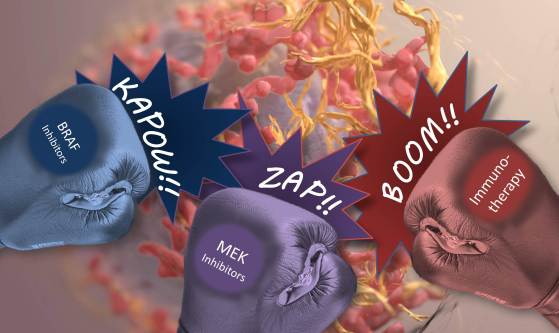Knocking Out Melanoma: Does This Triple Combo Have What It Takes?
 It would be great if we could knock out cancer with a single punch. But the more we learn about cancer’s molecular complexities and the immune system’s response to tumors, the more it appears that we may need a precise combination of blows to defeat a patient’s cancer permanently, with no need for a later rematch. One cancer that provides us with a ringside seat on the powerful potential—and tough challenges—of targeted combination therapy is melanoma, especially the approximately 50% of advanced tumors with a specific “driver” mutation in the BRAF gene [1].
It would be great if we could knock out cancer with a single punch. But the more we learn about cancer’s molecular complexities and the immune system’s response to tumors, the more it appears that we may need a precise combination of blows to defeat a patient’s cancer permanently, with no need for a later rematch. One cancer that provides us with a ringside seat on the powerful potential—and tough challenges—of targeted combination therapy is melanoma, especially the approximately 50% of advanced tumors with a specific “driver” mutation in the BRAF gene [1].Drugs that target cells carrying BRAF mutations initially provided great hope for melanoma, with many reports of dramatic shrinkage of tumors in patients with advanced disease. But almost invariably, the disease recurred and was no longer responsive to those same drugs. A few years ago, researchers thought they’d come up with a solid combination to fight BRAF-mutant melanoma: a one-two punch that paired a BRAF-inhibiting drug with an agent that sensitized the immune system [2]. However, when that combo was tested in humans, the clinical trial had to be stopped early because of serious liver toxicity [3]. Now, in a mouse study published in Science Translational Medicine, NIH-funded researchers at the University of California, Los Angeles (UCLA) provide renewed hope for a safe, effective combination therapy for melanoma—with a strategy that adds a third drug to the mix [4].
Melanoma accounts for less than 2 percent of skin cancer cases in the United States, but causes the large majority of skin cancer deaths. This year, it’s estimated that more than 70,000 Americans will be diagnosed with melanoma, and nearly 10,000 will die of the disease [5].
In work that utilized a mouse model of advanced melanoma, UCLA physician-scientists Antoni Ribas, Siwen Hu-Lieskovan, and their colleagues found that when they added a drug that blocks a protein called MEK to a combo of a BRAF inhibitor plus immunotherapy, the mice’s cancer was controlled more effectively, their immune responses were stronger, and they experienced fewer toxic side effects. On average, the mice that received the triple-combination therapy (MEK inhibitor trametinib + BRAF inhibitor dabrafenib + immunotherapy, either anti-PD1 antibody or tumor antigen-specific adoptive cell transfer) lived at least twice as long as those that received the double-combination therapies.
Researchers think one reason for the triple combo’s impressive performance in their experiments is that the MEK inhibitor—which acts upon the same biological pathway as BRAF inhibitors—not only bolstered the cancer-killing power of the BRAF inhibitor, but also alleviated its toxic effects in normal cells. Another thing that Drs. Ribas and Hu-Lieskovan found particularly encouraging was that, at least in mice, MEK inhibitors do not seem to impair the function of key immune cells called T cells. Previous studies on T cells grown in laboratory dishes had indicated that MEK inhibitors might have such an immune-suppressing effect.
The good news for people with advanced melanoma is that this field is moving very rapidly. Dr. Ribas and Hu-Lieskovan are among the researchers currently recruiting patients for three clinical trials of similar triple-combination therapies [6,7,8]. Early results from those trials are expected to be presented at the American Society of Clinical Oncology’s annual meeting May 29-June 2 in Chicago, so watch this space for further updates.
NIH-funded researchers are also working on combination therapies for many other types of cancer. In fact, one goal of our new Precision Medicine Initiative is to identify and test new combinations of cancer treatments, particularly those aimed at overcoming the problem of drug resistance.
References:
[1] Combining targeted therapy with immunotherapy in BRAF-mutant melanoma: promise and challenges. Hu-Lieskovan S, Robert L, Homet Moreno B, Ribas A. J Clin Oncol. 2014 Jul 20;32(21):2248-54.
[2] BRAF inhibitor vemurafenib improves the antitumor activity of adoptive cell immunotherapy. Koya RC, Mok S, Otte N, Blacketor KJ, Comin-Anduix B, Tumeh PC, Minasyan A, Graham NA, Graeber TG, Chodon T, Ribas A. Cancer Res. 2012 Aug 15;72(16):3928-37.
[3] Hepatotoxicity with combination of vemurafenib and ipilimumab. Ribas A, Hodi FS, Callahan M, Konto C, Wolchok J. N Engl J Med. 2013 Apr 4;368(14):1365-6
[4] Improved antitumor activity of immunotherapy with BRAF and MEK inhibitors in BRAFV600E melanoma. Hu-Lieskovan S, Mok S, Homet Moreno B, Tsoi J, Robert L, Goedert L, Pinheiro EM, Koya RC, Graeber TG, Comin-Anduix B, Ribas A. Sci Transl Med. 2015 Mar 18;7(279):279ra41.
[5] What are the key statistics about melanoma skin cancer? American Cancer Society, March 20, 2015.
[6] A Study of the Safety and Efficacy of Pembrolizumab (MK-3475) in Combination With Trametinib and Dabrafenib in Participants With Advanced Melanoma (MK-3475-022/KEYNOTE-022). Clinicaltrials.gov
[7] Phase 1 Safety and Tolerability of MEDI4736 in Combination With Dabrafenib and Trametinib or With Trametinib Alone. ClinicalTrials.gov
Links:
Melanoma (National Cancer Institute/NIH)
Precision Medicine Initiative and Cancer Research (National Cancer Institute/NIH)
Antoni Ribas, Jonsson Comprehensive Cancer Center, University of California, Los Angles (UCLA)
Siwen Hu-Lieskovan, UCLA
NIH Support: National Cancer Institute; National Center for Advancing Translational Sciences






















.png)











No hay comentarios:
Publicar un comentario